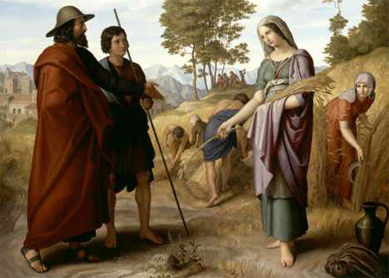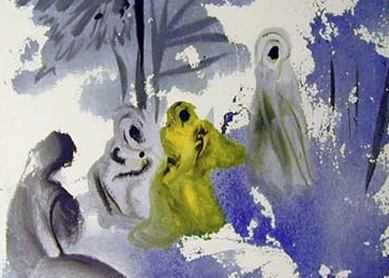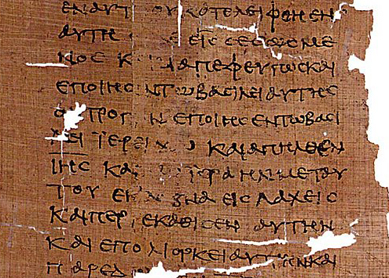Once upon a time….When you hear these words you immediately know that you are in a fairy tale. There will be a hero, a villain, and a happy ending. The details differ but the basic structure of the story will remain the same. No biblical story begins with “once upon a time,” but some signal that they are fairy tales through the use of a “timeless” setting, meaningful character names, and a strong moral lesson.
The story of Ruth begins “in the days when the judges ruled” (Ruth 1:1), yet the plot is not dependent upon anything specific to this time period (see also the openings of Job, Esther, and Judith). Rather, the tale is about a woman’s quest: Ruth journeys from widowhood, barrenness, and abject poverty to marriage, children, and prosperity. Rather than a villain, the protagonist of this fairy tale must overcome a lack: she lacks a husband and sons and therefore security. The tale is also about how goodness (“loving-kindness”) is rewarded. Like many a fairy-tale heroine, Ruth must persevere through adversity to obtain her goal; like many a fairy-tale moral, generosity, devotion, and love win the day.
Names emphasize elements of the plot and draw attention to the story’s lesson. The book of Ruth begins with a famine in the “House of Bread” (Bethlehem), suggesting the interplay between emptiness and fullness that structures the action. A man named Elimelech escapes the famine by moving his family to Moab. He dies. While there, his two sons marry Moabite women. The sons’ names—Mahlon and Chilion—rhyme and mean “Sickly” and “End,” so it should come as no surprise that they die without offspring. The three remaining women—Naomi, Orpah, and Ruth—are left without male kin. Ruth, whose name means “Friend” or “Satiation,” emerges as the hero when she refuses to leave her mother-in-law Naomi (“Pleasant”) on her journey back to Bethlehem. Later in the story, Naomi will declare herself Mara (“Bitter”) because she is bereft, and Ruth will meet Boaz (“Strength”), who turns out to be a much better marriage prospect than Sickly.
In fairy tales, the hero encounters someone or something that will aid in the successful completion of the quest; this meeting usually happens by chance. A good marriage is the goal of Ruth’s quest, and her fate changes when she leaves Naomi and goes to glean in the fields of Boaz, who turns out to be a rich near kinsman. Ruth is greeted, questioned, and tested by Boaz; in all that she does she is a model of goodness. In the next scene, Ruth leaves Naomi again to find Boaz on the threshing-room floor. Again, during the encounter she is greeted, questioned, and tested by Boaz; she is not found wanting and he pledges to marry her.
Lest our happy ending come too quickly, another plot obstacle must be overcome, this time by Boaz. There is another near kinsman who could lay claim to Ruth. The other man has a rhyming sing-song nonsense name, often translated “Mr. So-and-So.” Ruth’s Prince Charming challenges Mr. So-and-So and defeats him with verbal dexterity. Kindness, loyalty, and love have triumphed. Boaz and Ruth marry, Ruth bears a child, Naomi is restored. And they all live happily ever after.
Bibliography
- Sasson, Jack M. Ruth: A New Translation with a Philological Commentary and a Formalist-Folklorist Interpretation. Baltimore, Md.: Johns Hopkins University Press, 1979.
- Meyers, Carol, ed. Women in Scripture: A Dictionary of Named and Unnamed Women in the Hebrew Bible, the Apocryphal/Deuterocanonical Books, and the New Testament. Boston: Houghton Mifflin, 2000.
- Newsom, Carol A., Sharon H. Ringe, and Jacqueline E. Lapsley, eds. Women’s Bible Commentary. Rev. ed. Louisville, Ky.: Westminster John Knox, 2012.




